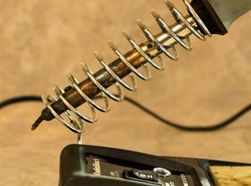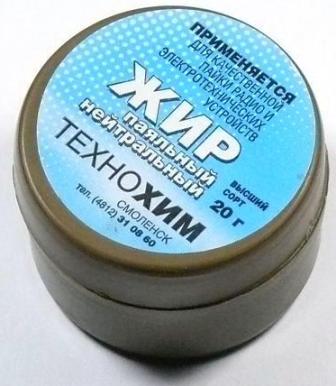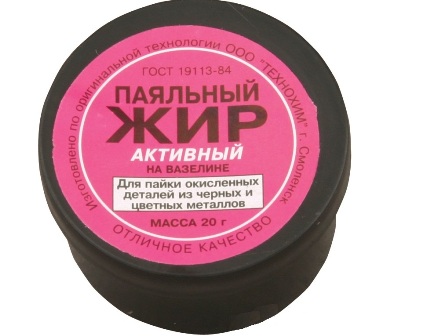Categories: Featured Articles » Sharing experience
Number of views: 49077
Comments on the article: 3
Solder fat and its use
 How many readers of this article, and how often, use solder fat in their practice? Surely the majority are much closer to liquid fluxes applied with a brush or just rosin. Meanwhile, solder fat is widely used as a full-fledged solder flux. Solder fat is available in two types: neutral solder fat and active.
How many readers of this article, and how often, use solder fat in their practice? Surely the majority are much closer to liquid fluxes applied with a brush or just rosin. Meanwhile, solder fat is widely used as a full-fledged solder flux. Solder fat is available in two types: neutral solder fat and active.
The vaseline-based active solder fat is excellent when it is necessary to solder even large parts of oxidized non-ferrous or ferrous metals, for this reason it is very useful in the household, almost like regular solder (zinc chloride) acid. Neutral solder fat is perfect as a regular flux during soldering any electrical and radio devices, printed circuit boards, etc. It is clear that active soldering fat does not need to be used for soldering radio parts, as is soldering acid.
Solder fat is generally intended for the same purposes as rosin, which is widespread at all times, it is also designed to remove the invisible oxide shell from the metal, and thus facilitate soldering. When rosin is not able to cope with this seemingly simple task, for example, it cannot remove the oxide shell from steel, then active soldering fat comes to the rescue as a good alternative.

Neutral solder grease, such as rosin-stearic grease, easily removes dirt and oxide films when brazing, say, copper using low-temperature solders, which is why neutral solder grease has gained great popularity both in industry and in everyday life.
Neutral solder grease is thick, so it adheres remarkably to a variety of metal contacts, to the terminals of radio components, so, unlike liquid fluxes, there is the possibility of a convenient and accurate dosage.
Grease can be applied quickly to many soldering places at once, using for example a match, a rough brush or a toothpick. If necessary, the residual solder fat is simply washed off with isopropanol, Kalosha gasoline, or with washing-up liquid, manually or in an ultrasonic bath.
So, the use of neutral solder grease is quite convenient and also a completely safe way to improve soldering, the speed and quality of soldering work is significantly increased.

Active solder fat, the basis of which consists of: petroleum jelly, paraffin, zinc chloride, deionized water and ammonium chloride, unlike the neutral solder fat mentioned above, has the best soldering properties, however, due to its high corrosivity, it requires mandatory thorough washing after soldering .
It is for this reason (due to corrosion activity) for PCB soldering active solder fat is not suitable. It is used only for soldering corroded and highly oxidized parts from ferrous and non-ferrous metals. Residues of active fat, by the way, are washed off quite easily, as well as in the case of using neutral solder fat.
See also: Types and designs of electric soldering irons
See also at e.imadeself.com
:
